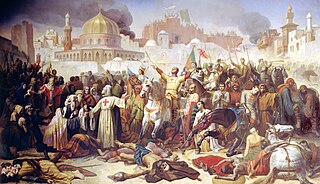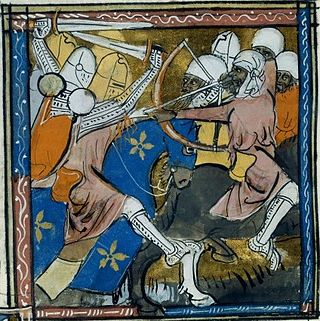Related Research Articles

Year 1099 (MXCIX) was a common year starting on Saturday of the Julian calendar.

The First Crusade (1096–1099) was the first of a series of religious wars, or Crusades, initiated, supported and at times directed by the Latin Church in the medieval period. The objective was the recovery of the Holy Land from Islamic rule. While Jerusalem had been under Muslim rule for hundreds of years, by the 11th century the Seljuk takeover of the region threatened local Christian populations, pilgrimages from the West, and the Byzantine Empire itself. The earliest initiative for the First Crusade began in 1095 when Byzantine emperor Alexios I Komnenos requested military support from the Council of Piacenza in the empire's conflict with the Seljuk-led Turks. This was followed later in the year by the Council of Clermont, during which Pope Urban II supported the Byzantine request for military assistance and also urged faithful Christians to undertake an armed pilgrimage to Jerusalem.

Baldwin I, also known as Baldwin of Boulogne, was the first count of Edessa from 1098 to 1100, and king of Jerusalem from 1100 to his death in 1118. He was the youngest son of Eustace II, Count of Boulogne, and Ida of Lorraine and married a Norman noblewoman, Godehilde of Tosny. He received the County of Verdun in 1096, but he soon joined the crusader army of his brother Godfrey of Bouillon and became one of the most successful commanders of the First Crusade.

Baldwin II, also known as Baldwin of Bourcq or Bourg, was Count of Edessa from 1100 to 1118, and King of Jerusalem from 1118 until his death. He accompanied his cousins Godfrey of Bouillon and Baldwin of Boulogne to the Holy Land during the First Crusade. He succeeded Baldwin of Boulogne as the second count of Edessa when he left the county for Jerusalem following his brother's death. He was captured at the Battle of Harran in 1104. He was held first by Sökmen of Mardin, then by Jikirmish of Mosul, and finally by Jawali Saqawa. During his captivity, Tancred, the Crusader ruler of the Principality of Antioch, and Tancred's cousin, Richard of Salerno, governed Edessa as Baldwin's regents.

The Principality of Antioch was one of the crusader states created during the First Crusade which included parts of modern-day Turkey and Syria. The principality was much smaller than the County of Edessa or the Kingdom of Jerusalem. It extended around the northeastern edge of the Mediterranean, bordering the County of Tripoli to the south, Edessa to the east, and the Byzantine Empire or the Kingdom of Armenia to the northwest, depending on the date.

Dagobert was the first Archbishop of Pisa and the second Latin Patriarch of Jerusalem after the city was captured in the First Crusade.
Fulcher of Chartres was a priest who participated in the First Crusade. He served Baldwin I of Jerusalem for many years and wrote a Latin chronicle of the Crusade.

The principality of Galilee was one of the four major seigneuries of the crusader Kingdom of Jerusalem, according to 13th-century commentator John of Ibelin, grandson of Balian. The direct holdings of the principality centred around Tiberias, in Galilee proper, but with all its vassals, the lordship covered all Galilee and southern Phoenicia. The independent Lordship of Sidon was located between Galilee's holdings. The principality also had its own vassals: the Lordships of Beirut, Nazareth, and Haifa.

Hugh of Fauquembergues, also known as Hugh of St Omer, Hugh of Falkenberg, or Hugh of Falchenberg was Prince of Galilee from 1101 to his death. He was Lord of Fauquembergues before joining the First Crusade. Baldwin I of Jerusalem granted him Galilee after its first prince, Tancred, who was Baldwin's opponent, had voluntarily renounced it. Hugh assisted Baldwin against the Fatimids and made raids into Seljuk territories. He established the castles of Toron and Chastel Neuf. He died fighting against Toghtekin, Atabeg of Damascus.

The role of women in the Crusades is frequently viewed as being limited to domestic or illicit activities during the Crusades. While to some extent this is true, they nevertheless played a significant role, taking part in such activities including armed combat in the battles of the Holy Land. This article focuses on the First Crusades and identifies known participants. It also highlights some of the more famous women of the later crusades. For a discussion of the sociological and religious aspects of the mixing of women with the predominantly male crusaders, the reader is referred to the referenced documents.
Raymond Pilet (1075–1120), the only child of Bernard I Pilet of Narbonne and his wife, whose name is unknown. Seigneur of Alès. Bernard was the son of Raymond II, Viscount of Narbone from 1066 to 1067. The name “pilet” refers to a fur that the nobility wore over their cuirass and coats-of-arms. Raymond distinguished himself as a combatant during the First Crusade.
The army of Hugh the Great was formed after the Council of Clermont, led by Pope Urban II in November 1095. Hugh, son of Henry I of France, and his wife Anne of Kiev, was Count of Vermandois, de jure uxoris, due to his marriage to Adelaide of Vermandois. In August 1096, Hugh and his small army left France in prima profectione, the first army of the third wave to leave France, and travelled to Bari, Italy, and then crossed the Adriatic Sea to the Byzantine Empire, in an armada commanded by Arnout II, Count of Aarschot. When Hugh entered Constantinople, he carried a Vexillum sancti Petri, a banner given to him by the pope, Hugh being the last such noble to carry the banner.
The army of Godfrey of Bouillon, the duke of Lower Lorraine, in response to the call by Pope Urban II to both liberate Jerusalem from Muslim forces and protect the Byzantine Empire from similar attacks. Godfrey and his army, one of several Frankish forces deployed during the First Crusade, was among the first to arrive in Constantinople. The army was unique in that it included among its warriors the first three kings of Jerusalem, although Godfrey preferred the title Defender of the Holy Sepulchre, Advocatus Sancti Sepulchri, as he believed that the true King of Jerusalem was Christ. This article focuses on the members of the army rather that its exploits which are described in detail in Godfrey’s biography as well as numerous sources listed below.

The first siege of Arsuf, originally Apollonia, took place in 1099, just after the First Crusade. It was carried out by Godfrey of Bouillon after the city failed to pay a previously agreed tribute. The attempt to capture the city failed for want of ships.
The army of Raymond of Saint-Gilles was one of the first to be formed after Pope Urban II called for the First Crusade. Raymond formed a Provençal army and left his County of Toulouse in October 1096, traveling over the land route. He was the only leader of a major army that did not swear an oath of fealty to Byzantine emperor Alexius I Komnenos.
The armies of Bohemond of Taranto, formed in 1097, include a major component of the First Crusade. He is regarded as the real leader of the First Crusade. He formed a second army in 1107 to defend Antioch but instead used it to attack the Byzantine emperor Alexios I Komnenos, resulting in the Treaty of Devol, codifying Bohemond’s defeat. Runciman estimates that the first army included 500 cavalry and 3500 infantrymen and other estimates that the second army was at 34,000 personnel strength are likely greatly exaggerated.
Robert II of Flanders' army was formed shortly after that of his kinsman Godfrey of Bouillon, arriving in Constantinople considerably later. His wife Clementia of Burgundy was regent of Flanders in his absence. The known members of the army, mostly Flemish, included the ones listed below, as reported in histories of the First Crusade. Unless otherwise noted, references are to the on-line database of Riley-Smith, et al., and the hyperlinks therein provide details including original sources. The names below are also referenced in the Riley-Smith tome, Appendix I: Preliminary List of Crusaders. Those references are not shown unless they appear elsewhere in the text of the book. Articles that are hyperlinked to a more detailed article in this encyclopædia rely on the latter for references.
The armies of Count Stephen of Blois participated in both the First Crusade of 1096 and the Crusade of 1101. Stephen apparently fled the battlefield at the Siege of Antioch and returned home. He was coerced by his wife, Adela of Normandy, to form another army to return to the Holy Land in 1101, accompanied by Count Stephen I of Burgundy.
The army of William IX on the Crusade of 1101 was formed by William IX “the Troubador,” Duke of Aquitaine, to fight in the minor Crusade of 1101. His army was destroyed by the Turks at Heraclea. Defeated, he reached Antioch with only six companions still alive.
The following is an overview of the armies of First Crusade, including the armies of the European noblemen of the "Princes' Crusade", the Byzantine army, a number of Independent crusaders as well as the People’s Crusade and the subsequent Crusade of 1101 and other European campaigns prior to the Second Crusade beginning in 1147.
References
- ↑ "A Database of Crusaders to the Holy Land, 1095-1149".
- ↑ Runciman, Steven. A History of the Crusades, Volume One. p. 313.
- ↑ Runciman, Steven. A History of the Crusades, Volume One. p. 316.
- ↑ Robinson, Edward (1841). "Biblical Researches in Palestine: Mount Sinaï and Arabia Petraea, 1841, pg 640".
- ↑ Thomas Asbridge (19 January 2012). The Crusades: The War for the Holy Land. Simon & Schuster. ISBN 978-1-84983-688-3.